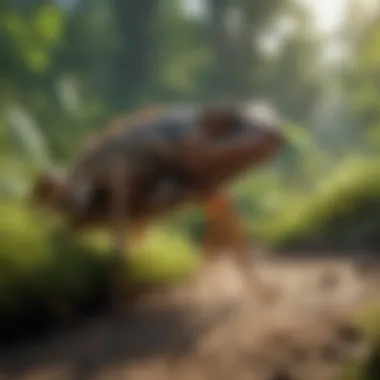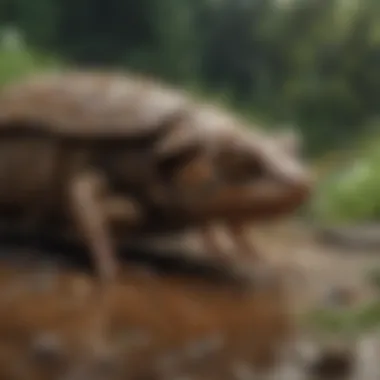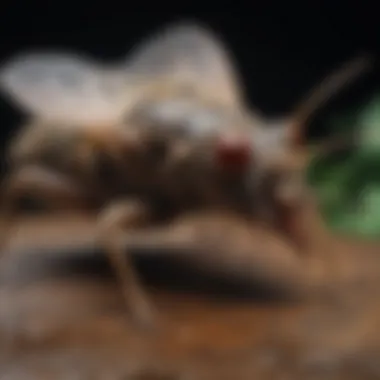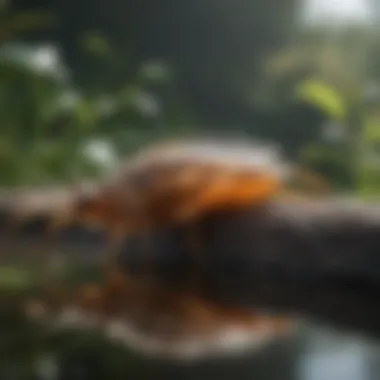Comprehensive Review of the Goodnature A18 Trap


Intro
The emergence of pests in residential areas poses significant challenges to homeowners, especially when it comes to maintaining a healthy and comfortable living environment. The Goodnature A18 trap stands out as an innovative solution focused on humane pest control. This analysis delves into the various facets of the A18 trap, shedding light on its design, functionality, and its role in a comprehensive and sustainable pest management strategy.
Understanding Pests
Definition of Pests
Pests are typically defined as organisms that can cause harm to human activities, particularly in homes and gardens. These can include insects, rodents, and even larger animals that disrupt daily life or damage property. Understanding the types of pests that are common in specific areas is vital for effective control.
Importance of Pest Identification
Correctly identifying pests is critical. Different species have varying behaviors and vulnerabilities. For example, while the Goodnature A18 trap is designed primarily for rodent control, knowing whether one is dealing with mice, rats, or another rodent type can drastically affect the success of pest management efforts. Effective pest identification helps in applying the most appropriate strategies for control.
Prevention Techniques
Home and Garden Preventative Measures
Prevention always takes precedence over eradication. Homeowners can take several measures:
- Sealing Entry Points: Inspecting and sealing cracks and gaps around windows, doors, and foundations can keep rodents out.
- Proper Waste Management: Keeping garbage in sealed bins reduces food availability for pests.
- Garden Maintenance: Regularly trimming plants and removing debris can minimize hiding spots.
Seasonal Prevention Tips
Pests often adapt their behaviors with seasons. Understanding these changes can aid in better prevention:
- Fall: Rodents seek warmth, so check for openings in the home.
- Spring: As plants grow, pests like aphids may increase; establish treatments early.
Eco-Friendly Pest Control Solutions
Overview of Sustainable Practices
Sustainable pest management emphasizes minimizing harm to the environment. The Goodnature A18 trap incorporates eco-friendly principles. It is designed to be reused, reducing waste compared to traditional traps. Using traps that do not rely on poisons is crucial, as it mitigates risks to pets and children.
Natural Remedies and Their Effectiveness
Many homeowners explore natural remedies for pest control. Some of these may include:
- Diatomaceous Earth: A natural powder that terrifies insects without the use of chemicals.
- Essential Oils: Some, like peppermint and rosemary, can deter pests when used in sprays.
"Combining traditional methods with modern innovation is key to effective pest control. The Goodnature A18 trap embodies this philosophy."
Understanding the products available and how they affect the ecosystem strengthens one's approach to pest management. The Goodnature A18 trap exemplifies this balance, providing a humane and effective solution to a perennial problem.
Epilogue
Prelims to the Goodnature A18 Trap
The Goodnature A18 trap has emerged as an innovative solution in the realm of pest control, specifically designed to address issues related to rodent infestations. Understanding the dynamics of this trap is crucial for homeowners and pest management professionals alike. In this section, we will explore the origins, development, purpose, and scope of the Goodnature A18 trap, providing a foundation for comprehending its significance in sustainable pest management.
Origins and Development
The Goodnature A18 trap was developed in response to growing concerns about the environmental impact of traditional rodent control methods. It represents a significant advancement in humane pest management strategies. The company Goodnature, based in New Zealand, committed to creating a trap that minimizes harm to non-target species while effectively reducing rodent populations. Through extensive research and testing, the A18 trap was refined to ensure both reliability and efficeincy. The technology behind it involves sophisticated mechanics, setting it apart from standard traps.
Purpose and Scope
The purpose of the Goodnature A18 trap is to provide an effective and humane method for controlling rodent populations. Unlike conventional spring-loaded traps that can cause unnecessary suffering, the A18 is designed for quick and efficient execution. Its scope extends beyond mere control; it aims to educate users about responsible pest management practices. This makes it suitable not just for homeowners but also for commercial establishments needing ecologically sound solutions. By fostering a deeper understanding of rodent behaviors and population dynamics, the A18 trap aligns itself with modern sustainability goals, enhancing its relevance in today’s pest management landscape.
Design Features of the Goodnature A18 Trap


The design of the Goodnature A18 trap plays a crucial role in its overall effectiveness and user friendliness. Each aspect of its construction has been thoughtfully engineered to enhance both its functionality and durability. This section delves into the materials used, the mechanism behind its operation, and the overall dimensions and portability of the trap—all essential features to consider when evaluating its suitability for pest management.
Materials Used in Construction
The Goodnature A18 trap is made from high-quality materials that ensure longevity and reliability. Most notably, its outer casing is made from robust plastic that is resistant to weathering and impacts. This characteristic allows the trap to withstand various environmental conditions, making it suitable for both indoor and outdoor use. The internal components also include stainless steel, a material chosen for its strength and resistance to rust, further enhancing the trap's lifespan.
In addition, Goodnature has focused on eco-friendly materials, aligning with its commitment to sustainability. The use of safe, non-toxic materials reduces the environmental impact, making it a preferred choice for those who prioritize ecological responsibility.
Mechanism of Action
The mechanism of the Goodnature A18 trap is engineered for efficiency and effectiveness. At its core, this trap employs a self-resetting design powered by a carbon dioxide (CO2) canister, which allows it to function without frequent re-baiting or resetting by the user. This unique feature differentiates it from traditional traps, offering continuous operation until the gas is depleted.
When triggered by a rodent, the trap delivers a controlled strike, ensuring a quick and humane capture. This mechanism is not only less labor-intensive but also provides a consistent success rate. Users find that this design minimizes the need for repeated visits to check traps.
Dimensions and Portability
The Goodnature A18 trap comes in a compact and lightweight form, measuring approximately 24.5 cm in height and 12.5 cm in width. Such dimensions facilitate easy placement in various settings, whether in a pantry, garage, or garden. A major benefit of its design is the ease of transportation. Households that may need to relocate traps can do so without hassle. The trap can conveniently fit in most bags or car trunks, making it accessible for users.
Entrusting individuals with the capability to strategically place traps in different locations enhances the overall effectiveness of pest control. Moreover, the streamlined design ensures it takes up minimal space without sacrificing its functionality.
"A well-designed trap not only enhances pest control efficiency but also reduces human effort in managing it."
Functionality of the Goodnature A18 Trap
Understanding the functionality of the Goodnature A18 trap is essential for anyone considering its use. It reveals how this device operates effectively to manage pest populations with minimal ecological impact. This section will explore various aspects of functionality that make the Goodnature A18 an attractive option for homeowners and pest management professionals.
Target Pests
Types of Rodents Captured
The Goodnature A18 trap is designed to capture a variety of rodent species, particularly rats and mice. These pests are notorious for causing damage to property and contaminating food supplies. One key characteristic of the A18 is its effectiveness in targeting both house mice and Norway rats. This specificity is beneficial for users who aim to address common household pest issues without inadvertently catching non-target species.
The unique feature of the trap is its dual-action mechanism, which not only captures but also kills quickly, ensuring minimal suffering for the animal. This aspect contributes to its acceptance among users who prioritize humane treatment in pest control methodologies. Understanding the types of rodents that the trap can handle is crucial for establishing its applicability in various residential settings.
Behavioral Patterns of Target Species
Behavioral patterns of the targeted rodent species play a significant role in the effectiveness of the Goodnature A18 trap. Rodents are often nocturnal and can exhibit cautious behavior, especially in familiar environments. Recognizing these patterns is beneficial for effectively placing the traps. The trap's design facilitates a high catch rate by using bait that appeals to the natural instincts of the rodents, enticing them to engage with the trap.
Another important characteristic is the trap's ability to reset itself after each capture, which is unique compared to traditional traps. This automatic resetting mechanism allows homeowners to maintain pest control with less frequent intervention. By accommodating the behavioral patterns of these pests, the Goodnature A18 enhances its overall efficiency as a pest management tool.
How the Trap Operates
The Goodnature A18 operates based on a simple yet effective mechanism. It is a self-resetting trap that uses a combination of bait and a spring-loaded platform to capture rodents. When a rodent interacts with the bait, the trap is triggered. This action activates a powerful strike that humanely dispatches the pest.
The design allows the trap to reset automatically, readying it for the next rodent without any need for manual resetting. This continuous operation is advantageous for users who may have ongoing pest issues. Furthermore, it minimizes the time and effort required in traditional trapping methods, making it a more efficient option.
Maintenance and Care
Maintaining the Goodnature A18 trap is straightforward but essential to ensure longevity and performance. Regular cleaning of both the bait compartment and the striking platform helps keep the trap functioning effectively. Over time, residues and non-target animals may cause the trap to malfunction, so keeping it clean reduces this risk.
It is advisable to check the trap every few days to monitor for captures and to refresh the bait. The basic principles of maintenance include:
- Regular cleaning of the trap
- Replacing bait every 2-4 weeks
- Inspecting the trap for damage before each use
With proper maintenance and care, the Goodnature A18 trap can provide reliable service in any pest management strategy.
Effectiveness of the Goodnature A18 Trap
Understanding the effectiveness of the Goodnature A18 trap is essential for any homeowner or pest management professional. Effectiveness not only involves capturing pests efficiently but also minimizing harm to non-target species and the environment. This section delves into its performance, providing insights into how it compares to traditional methods, its success rates, and the factors that can influence its overall effectiveness.
Comparison with Traditional Traps


When examining the Goodnature A18 trap, it is crucial to compare it with traditional traps. Traditional traps often rely on poisons or mechanical mechanisms that pose risks to non-target animals and the ecosystem. In contrast, the Goodnature A18 trap is designed for efficiency and humaneness. It utilizes a unique autotrigger system that resets itself automatically after each catch, allowing for continuous use without the need for manual resetting. This design feature enhances its effectiveness by ensuring that no rodents are able to escape once they encounter the trap.
Additionally, unlike many traditional traps, which can require frequent checks, the Goodnature A18 allows homeowners to set it and forget it for longer periods. This efficiency reduces the labor hours associated with pest management.
Success Rates and User Feedback
User feedback indicates that the Goodnature A18 trap has a high success rate among various rodent species. Many users have reported significant reductions in rodent populations, emphasizing how quickly and effectively the trap works. A study conducted by independent reviewers highlighted success rates surpassing those of common snap traps and glue traps, offering reassurances to potential users.
"The Goodnature A18 has consistently performed better than any trap I’ve previously used. I noticed a drop in noises at night within days of installation."
Many house owners appreciate the eco-friendly design, which uses no chemicals or poisons, making it a safer option for households with pets and children. Reviews often highlight the trap's effectiveness against persistent species like Norway rats and roof rats, noting that these rodents learn quickly and avoid traps. However, the auto-reset feature of the Goodnature A18 keeps the user confident in its potential success.
Factors Influencing Performance
Several factors can affect the performance of the Goodnature A18 trap. Firstly, the trap's placement is vital. It should be located in areas with high rodent traffic, such as along walls or near food sources. Bait selection is another critical aspect; using bait that is appealing to rodents can significantly enhance success rates.
Environmental conditions also play a role. In outdoor settings, weather can influence the trap's effectiveness. Protecting it from rain and snow while ensuring it remains accessible to rodents is essential. Additionally, the trap must be maintained properly, as dirt or debris can hinder its operation. Regular checks for cleanliness and functionality can ensure the trap works effectively.
Understanding these factors helps users optimize their experience with the Goodnature A18 trap. When set up correctly, it becomes a powerful tool in the ongoing effort to manage rodent populations in a sustainable, humane way.
Ecological Considerations
Understanding the ecological considerations of the Goodnature A18 trap is essential for both users and pest management professionals. It delves into how such traps can affect the environment, not only in terms of their direct efficacy but also concerning sustainable practices and impacts on non-target species. Evaluating these factors contributes significantly to informed decision-making regarding pest control and enhances awareness of the broader ecological impacts.
Sustainability in Pest Control
Sustainability is a critical aspect of modern pest management. The Goodnature A18 trap embodies this principle through its design and operation. Its primary advantage is its ability to eliminate target pests efficiently while minimizing environmental impact.
- Non-toxic Operation: This trap does not rely on chemical pesticides, which can harm the surrounding ecosystem. Instead, it employs a mechanical method that captures rodents without poisons.
- Reusable Mechanism: The trap is designed for repeated use, reducing waste production as compared to traditional traps that require frequent replacement. This feature not only promotes sustainability but also offers cost benefits over time.
- Eco-Friendly Materials: The materials used in the construction of the Goodnature A18 are selected with environmental considerations in mind, ensuring durability without the ecological footprint associated with less sustainable alternatives.
Utilizing such sustainable measures emphasizes responsible pest control methods that align with environmental stewardship.
Impact on Non-target Species
A critical aspect of using any pest control method is the impact on non-target species. The Goodnature A18 trap is engineered to focus on specific rodent species, thereby reducing unintended harm to other wildlife.
- Precision Targeting: The design and mechanism of action make it less likely to catch non-target animals. This precision is crucial in residential areas and gardens where various species coexist.
- Minimal Disturbance: The trap’s operation has a low level of environmental disturbances, which supports the maintenance of biodiversity. This quality is especially important in urban settings where many animals including birds, pets, and beneficial insects might be present.
Maintaining a safe environment for non-target species is not only an ethical concern but also an ecological necessity.
Ethical Implications
Ethical considerations in pest control are gaining prominence among environmentally conscious individuals. The Goodnature A18 trap addresses these concerns through responsible design and operational methods.
- Humaneness: Unlike traditional traps that may cause prolonged suffering, the Goodnature A18 offers quick and humane eliminates rodents. This approach aligns with modern ethical standards advocating for the humane treatment of all creatures.
- Transparency and Awareness: Users of the trap benefit from understanding its operation and the rationale behind its eco-friendly features. This transparency fosters responsible use and encourages dialogues about effective pest management among homeowners and communities.
- Respecting Ecosystems: Ethical pest control recognizes the interconnectedness of species within an ecosystem. Employing strategies that do not disrupt these relationships reflects a commitment to ecological balance.
By prioritizing humane and eco-conscious methods, the Goodnature A18 trap allows homeowners not just to manage pests but to do so with respect for the world they inhabit.
Investigating and applying these ecological considerations enhances the effectiveness of pest management and promotes a healthier environment for both humans and wildlife.
Setting Up the Goodnature A18 Trap
Setting up the Goodnature A18 trap is a critical step towards effective pest management. Proper setup ensures that the trap operates at its full potential and provides a humane solution to rodent problems. Understanding how to systematically position the trap can lead to higher capture rates and minimize frustrations associated with incorrect placement. Key factors to consider include site selection, baiting techniques, and being aware of common mistakes during the setup process.
Site Selection
Selecting the correct site for the Goodnature A18 is vital for its functionality. The trap should be placed in areas where rodent activity is noticeably high. Look for signs such as droppings, gnaw marks, or nests which indicate the presence of pests. A good practice is to map out the external environment, focusing on likely entry points like doors, windows, and vents. Preferred locations are often near food sources or potential nesting sites. An ideal setup height is one that ensures the trap is not easily disturbed but remains accessible for maintenance.
Factors to consider in site selection:


- Rodent Activity Indicators: Identify hotspots of activity.
- Avoid High Traffic Areas: Ensure that pets or children cannot access the trap.
- Weather Protection: Make sure the trap is shielded from harsh weather, which can affect trap performance.
Baiting Techniques
Baiting is an essential component in maximizing the effectiveness of the Goodnature A18. The choice of bait can significantly influence whether rodents will approach the trap. It is recommended to use baits that are particularly appealing to rodents, such as peanut butter or sunflower seeds. Proper baiting involves placing the bait in the designated bait compartment of the trap.
Consider these strategies when baiting:
- Freshness of Bait: Use fresh and attractive bait to draw in rodents.
- Sufficient Quantity: Use enough bait but not too much, as excess can make the trap less effective.
- Regular Monitoring: Change the bait regularly to maintain its appeal and ensure it remains uncontaminated.
Common Mistakes to Avoid
Even with good intentions, errors can occur during the setup process. Recognizing and avoiding common mistakes can enhance the trap's performance and overall experience for users.
Beware of these pitfalls:
- Incorrect Positioning: Placing the trap in areas without rodent activity.
- Inadequate Bait: Using bait that is either insufficient or unappealing will deter rodents.
- Ignoring Maintenance: Failing to inspect the trap and change the bait can lead to decreased effectiveness over time.
Ensuring a proper setup of the Goodnature A18 trap is not just about placement and baiting; it is about strategically engaging with the pest problem to achieve a lasting solution.
By understanding the nuances of setup, users can provide a humane and eco-friendly method of pest control that is effective and sustainable.
Cost Analysis
Understanding the cost associated with the Goodnature A18 trap is essential for homeowners and pest management professionals. This section aims to analyze both the initial investment required to purchase the trap and the potential long-term savings it offers. By assessing these factors, readers can make informed decisions that balance their budget while addressing rodent issues effectively.
Initial Investment
The initial investment for the Goodnature A18 trap may seem steep compared to traditional rodent traps. However, the design and features incorporated into this device justify the price. The trap is built with high-quality materials which enhance durability, making it a long-lasting solution. The retail price of the Goodnature A18 trap typically ranges between $150 to $200, depending on the vendor.
Among the elements contributing to this cost are:
- Design Efficiency: The mechanical components ensure reliable operation without frequent replacements.
- Eco-Friendly Features: It employs a self-resetting mechanism, thus reducing the need for continuous manual intervention, which can be a hassle.
- Ease of Use: The trap is user-friendly and often requires minimal setup time, making it accessible for those who are not experts in pest control.
While the upfront cost is a consideration, it is important to evaluate it in the context of effective pest management.
Long-term Savings
In the long run, investing in the Goodnature A18 trap can lead to significant savings. First, consider the reduction in costs related to pest control services. Hiring professionals can become quite expensive, often ranging from $100 to $300 per visit, depending on the severity of the infestation. In contrast, the cost of the Goodnature A18 trap is a one-time purchase that eliminates the need for recurring service fees.
Additionally, the effectiveness of capturing and eliminating rodents efficiently contributes to:
- Less Property Damage: Rodents can cause extensive damage to homes, leading to costly repairs. By effectively controlling the rodent population, homeowners can avoid further expenses.
- Health Benefits: The trap helps in reducing health risks associated with rodents, which can lead to medical costs.
A detailed calculation shows that with just a few successful captures, the trap pays for itself over time. The investment in the Goodnature A18 trap is not merely a cost; it is an investment in a sustainable and effective rodent control strategy.
"Investing in the Goodnature A18 trap is not just about the initial price; it’s about long-term value and peace of mind."
By carefully analyzing both the initial costs and the long-lasting benefits, homeowners can make a well-informed choice that aligns with their pest management goals.
Culmination and Recommendations
In concluding the analysis of the Goodnature A18 Trap, it is crucial to emphasize the blend of design, functionality, and ecological consideration that this trap brings to the table. The Goodnature A18 Trap stands out as a robust solution tailored for responsible pest management. Its efficacy against various rodent species aligns well with contemporary demands for humane pest control methods.
Final Thoughts on the Goodnature A18 Trap
The Goodnature A18 Trap is an innovative device that reflects a fusion of technology and environmental consciousness. It operates efficiently while minimizing harm to non-target species, setting a new standard for modern traps. For individuals and professionals committed to sustainable pest control, integrating such equipment into their practices can significantly enhance outcomes.
Moreover, the ease of maintenance and the trap's design make it a viable choice for both homeowners and pest management professionals alike. The automatic reset feature and the long-lasting nature of the bait reduce the frequency of checks, making it a practical option for busy lifestyles. Users can appreciate a trap that works continuously without sacrificing ethical standards in pest control.
Best Practices for Users
To maximize the benefits of the Goodnature A18 Trap, adhering to best practices is essential. Consider the following recommendations:
- Site Selection: Evaluate areas with high rodent activity. Over time, identifying hotspots enhances efficiency in pest control.
- Use Appropriate Bait: Utilize baits that appeal specifically to the target species for optimized functionality. Baits such as peanut butter often yield better results.
- Regular Checks: Although the trap is designed for less frequent monitoring, regular checks ensure it remains operational. Users should clear debris and check for any mechanical issues.
- Educate Yourself: Understanding the behavioral patterns of the targeted rodents improves the chances of capture. Awareness of their habits can guide placement decisions.
- Be Patient: Sometimes, it may take time for rodents to interact with the trap. Patience is a vital part of the process.
By following these best practices, users can ensure that they are getting the most out of their investment in the Goodnature A18 Trap. This thoughtful approach will lead to effective results and more sustainable pest management solutions.



